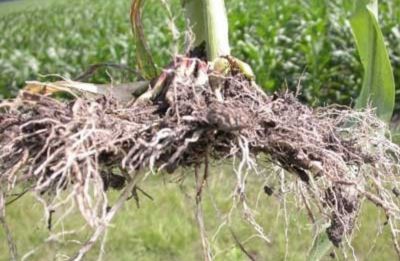 Image: Flat corn root development in drought conditions (GROWMARK, Inc.)
Image: Flat corn root development in drought conditions (GROWMARK, Inc.)
- Drought prevents the crop from accessing many vital nutrients.
- Foliar applications may help temporarily supply nutrients to deficient crops.
- Ensure that tissue tests are done prior to applications to ensure proper product selection.
Many parts of the Midwest have been in drought conditions for multiple weeks. Drought has many impacts on the crop, most obviously reducing water availability. Another consequence of drought is reduced availability of some key nutrients. When drought occurs, it is difficult for the plant to access soil nutrients. Many nutrients move to our plants with soil water in a process known as mass flow. Examples of such nutrients include nitrogen, potassium, sulfur, and boron.
Many people are curious about what options they may have to help reduce these deficiencies during this current dry period. There are few options available to us to help manage drought induced nutrient deficiencies. Foliar-applied nutrients can help to deliver a small amount of nutrients to the plant, and this may act as a short-term help to the plant; however, the quantity of nutrients will not sufficiently compensate for what is needed by the crop. Keep this in mind when considering a foliar nutrient application.
Tissue tests help provide guidance on what nutrients are deficient and therefore, what products will provide us the most benefit. It is important to note that the deficiencies we see, visual or on a tissue test, are induced by the lack of water. If we get rainfall between sampling and application the tissue sample results may not be valid.
A final, and extremely important consideration is root development. Has the crop suffered from any issues such as compaction, mohawking, or insect/pathogen damage that have exacerbated the situation? Damage or underdeveloped root systems may impact harvestability. If you have fields with nitrogen or potassium deficiency ensure that those are evaluated at harvest and prioritized for harvest if needed.
